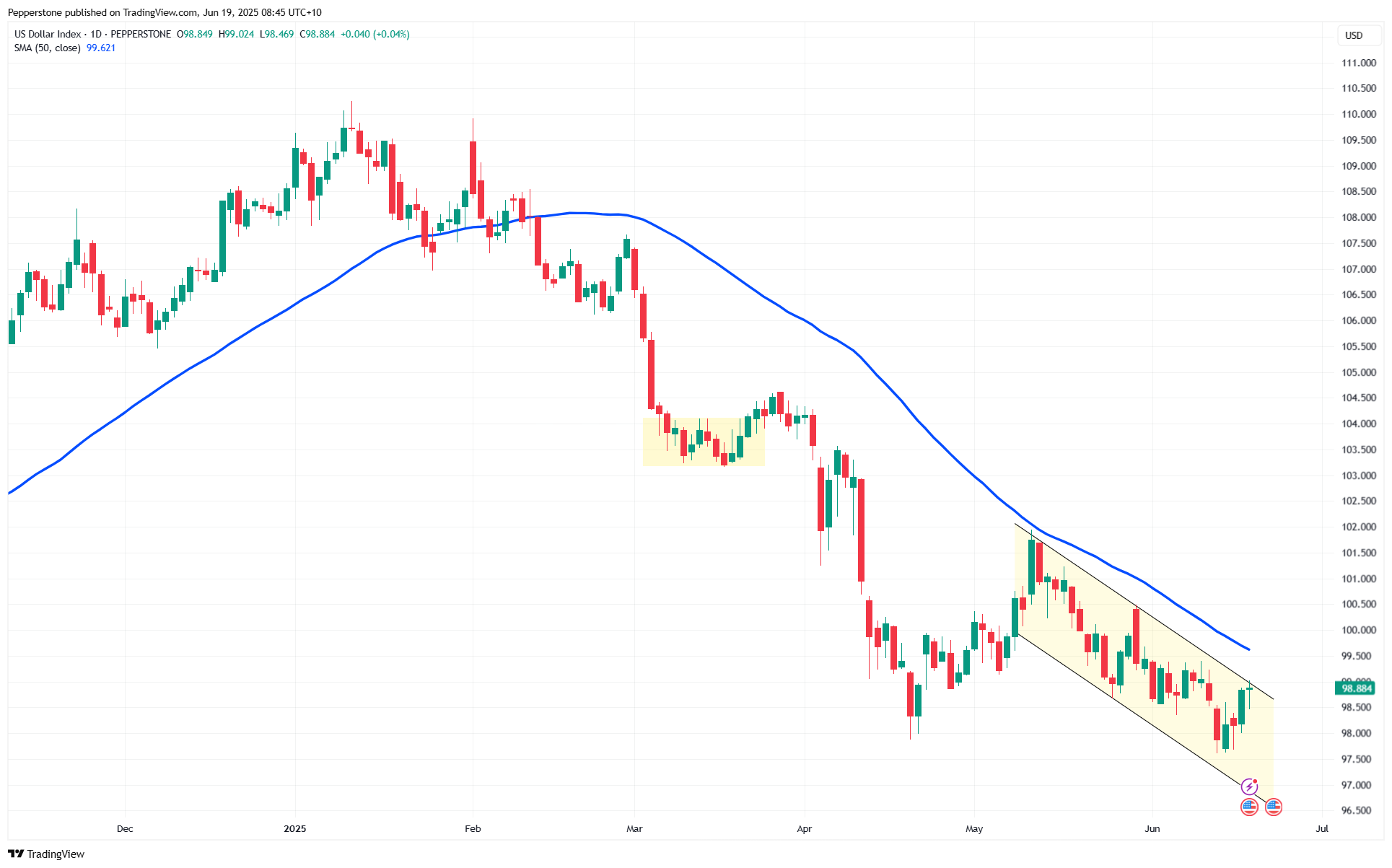CFDs are complex instruments and come with a high risk of losing money rapidly due to leverage. 72.2% of retail investor accounts lose money when trading CFDs with this provider. You should consider whether you understand how CFDs work and whether you can afford to take the high risk of losing your money.
- English
- Italiano
- Español
- Français
Energy Markets Guide Asia Risk as the Fed Highlights Inflation Priorities

The Fed meeting pulled the attention temporarily away from Trump’s frequent defiant views on Iran, even if the sensitivity towards the geopolitical risk has largely been contained to the energy markets. The wash-up of the Fed meeting was that markets were treated to a modestly dovish refreshed set of economic projections and Dots, which were subsequently offset by a slightly more hawkish-than-expected presser from Chair Powell.
The Fed maintains a central projection for two rate cuts in 2025, although behind the surface seven officials now project no cuts in 2025 vs four in the March meeting. We see fewer cuts projected for 2026, although we put less weight on the 2026 'dot' as the Fed’s visibility to make assumptions this far out is tough, and that call is more about putting numbers out to the market so as to offer a loose guide around their thinking. We see a central view of slower growth for 2025, with higher inflation, although these new projections were well-telegraphed and very much in line with market expectations.
The Fed's primary focus is on inflation
What was interesting is that Chair Powell has swayed the balance of their focus towards the tariff impact on goods inflation that will partly contribute to driving core PCE toward 3.1% by Q425. Powell made it clear that while the mantra of wait and see if still very much unchanged, inflation is their dominant concern, and the labour market and growth come in closely behind. Of course, with Q2 GDP likely to be robust and the labour market still in a good place, one can understand the Fed’s thought process, but it does suggest that when tariff rates do settle and are ingrained into business plans the markets pricing of inflation expectations will matter a lot to equity risk and the USD.
It also suggests that if US weekly jobless claims were to rise to say 280k and should this be met with a weak nonfarm payrolls print, at or below 80k, then this weaker labour market dynamic, when the Fed are focused more intently on inflation, would likely send a wave of derisking through markets. It may not happen anytime soon, but in this scenario, the market would send a message to the Fed that its focus is misplaced.
We can see the reaction perhaps best portrayed through the US 5-year Treasury – given this is part of the Treasury curve fixed income investors seem to find most attractive right now. In reaction to the Fed statement (and SEPs) yields initially pulled -3bp to 3.92% before the sellers took over pushing the yield closer to 4%, before settling largely unchanged on the day. US Rates/swaps pricing remains in check, with 48bp of implied cuts from the Fed still the central case priced through to December. There has been little change to expectations for the Fed’s terminal rate, with market pricing implying that the Fed could take the Fed funds rate to 3.32% by late 2026.
FX moves on the day
The USD has seen mixed performance across the major currencies on the day – and while the FX channels have an eye out for any sharp moves coming in Brent crude, we see the AUD and NZD outperforming, with the SEK underpaying post the Riksbank meeting, while the Petro-currencies – the NOK and CAD - have lost ground and held back by a choppy crude price.

The DXY is threatening a bullish break of short-term channel resistance but really needs to clear the 50-day MA (99.55) to compel a sizeable pool of short positioning – held notably by real money accounts – to cut back. This could take the DXY to 102, although that would need EURUSD to pull lower to 1.1200. For the USD bears, this could be a welcomed development, as a solid flush out of USD shorts would offer a cleaner entry point.
Levels that define US equity risk
S&P500 futures have been choppy through trade, finding better sellers into 6020 but seemingly finding buyers supporting into 5980. US cash equity closed largely unchanged with tech keeping the index from falling into the red, with breadth well balanced. At an index level consolidation remains the play and it seems that the near-term ranges of 6070 to 5925 define the risk for now – a breakout of either level would be of interest.
Looking ahead, headlines on developments in the Middle East will be the central focus for many, with reports surfacing that Trump has approved attack plans for Iran but has held back to give Iran a final chance to cede its nuclear enrichment capabilities. Headline risk will therefore be a core factor for traders to navigate, with potential volatility seen within energy markets, a factor which could see gold and the USD (to a lesser extent) following the crude moves.
On the data side, we get Aussie jobs, and the BoE meeting will almost certainly leave rates on hold.
The material provided here has not been prepared in accordance with legal requirements designed to promote the independence of investment research and as such is considered to be a marketing communication. Whilst it is not subject to any prohibition on dealing ahead of the dissemination of investment research we will not seek to take any advantage before providing it to our clients.
Pepperstone doesn’t represent that the material provided here is accurate, current or complete, and therefore shouldn’t be relied upon as such. The information, whether from a third party or not, isn’t to be considered as a recommendation; or an offer to buy or sell; or the solicitation of an offer to buy or sell any security, financial product or instrument; or to participate in any particular trading strategy. It does not take into account readers’ financial situation or investment objectives. We advise any readers of this content to seek their own advice. Without the approval of Pepperstone, reproduction or redistribution of this information isn’t permitted.